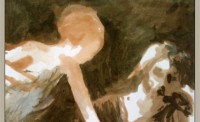 Brushes With
Brushes With
by Kristina Marie Darling
BlazeVOX [books], 2013
50 pages / $16.00 buy from BlazeVOX or Amazon
1. This is Kristina Marie Darling’s 11th book of poetry; she is not even 30 years old yet.
2. Darling eschews traditional forms of poetry in favor of her own unique formal constraints: the use of footnotes, appendixes, images, definitions, bracketed verse, and erasure poetry. However, in Brushes With, Darling adds a new form to her repertoire: the narrative prose poem.
3. The collection begins: “We were no longer in love. The sky, too, was beginning to show its wear.” From this point forward, readers are plunged into many complex layers of the rubble of abandonment and loss.
4. The footnotes serve as historical commentary on the prose text. This makes for a matrix-like experience. We are reading a person’s intimate words, but we also know that this text has been abandoned, then found, then studied, then put on display. This technique makes the experience of reading the prose poems feel illicit in some way. We are peering into a labyrinth of secrets that are not meant for our eyes, yet are now uncomfortably preserved and public.
5. Even while reminiscing on the relationship before its end, the speaker foreshadows doom: “You told me there was dark matter I couldn’t see. That every star is a dead star.”
6. The imagery, like the one above, proves to be richly complex. All stars are dead; therefore, that which enchants us, that which we wish upon, that which we map out, gaze upon, pray to, is also doomed. In every romantic union, there is something dark that we don’t see coming, yet we should be aware that it’s there.
7. In “Feminism,” the speaker states: “I began to realize the significance of this gesture. What is love but a parade of memorable objects, a row of dead butterflies pinned under glass?” Ouch!
8. The speaker’s take on love is relentlessly jaded, yet she comes to sharp edged truths. What is love but our desire to possess, collect, admire. Yet, in doing so, we must sacrifice the subject’s life.
9. Footnote 18. ‘This statue of the Holy Mother would later be found headless in a tiny museum in northern France.” Once again, we have worship, mementoes, collection, ownership—all leading to destruction. Facelessness.
10. The marriage documented in the book unravels due to affairs.
11. Footnote 22. “She began referring to the affair as a ‘benevolent guillotine.’ The silver blades poised to kill.” Wow…just wow. The unhappiness in the union proves itself so profound that the betrayals become merciful in their ability to destroy her.
12. Some pages lack prose poems, and only have footnotes. This is an evocative imaginative tool: the reader begins to attempt to fill in narrative gaps with a myriad of suggested possibilities.
13. In “Spectacle,” the speaker says, “Day after day, you demand the same perfectly timed applause.” Here, love equates to narcissistic worship.
14. Therefore, love is staged, love is absurd.
15. Darling often works with repeated tropes in her collections. InBrushes With, repeated imagery include a green dress, maps, stars, a house by the sea, statues, machinery and breadknives. Each image is loaded with possible associations and connotations every time it appears in the text. They tend to shift and take on new meaning with every usage.
16. The illustrations in the end compliment the book’s themes powerful. In one image, the interior of a burned house. Wreckage, destruction, abandonment, something needing preservation and salvation.
17. In another image a picture of stars in the sky with the caption: “A burial ground for dead stars.” A reminder: things are not what they seem. Things are also not what we want them to be.
18. Darling’s text feels deliciously postmodern in its meta construction. Absent text, fragments of memories, an incomplete story, an absent lover—she blurs the lines between destruction and creation, love and loss.
19. Darling fully engages the audience in the writing: you fill in the imaginative gaps and missing narrative, making the experience of reading her book a collaborative endeavor between author and reader.
20. While Brushes With, like other works of Darling, feels as if it occurs in the Victorian era, the issues presented about romance are bitingly contemporary.
21. Fans of poet H.D. will find much to admire in Darling’s work—I see many parallels between the two writers, particularly in her use of imagery. The book begins with an epigraph from H.D. and Anon.
22. Footnote 19: “Violence: 1. The use of physical coercion. 2. The relative strength or duration of an emotion.”
23. Darling’s definitions, like the one above, chafe against each other, and in doing so, they are wildly enlightening: we are abused by others, but we are also abused by our own all consuming love of others.
24. In a blurb on the back cover, Bhanu Kapil states that this book “felt, at times, like an act of beautiful revenge.” This seems accurate: this is a short poetry collection that feels burdensomely heavy.
25. Kristina Marie Darling’s work is a reading experience like no other poet I have ever encountered. Every lover of poetic craft will relish the defiant ways she’s transforming and subverting traditional forms of poetry. She remains wildly imaginative, refreshingly unique, and even frighteningly evocative.
Tags: 25 Points, blazevox, Brushes With, Kristina Marie Darling
